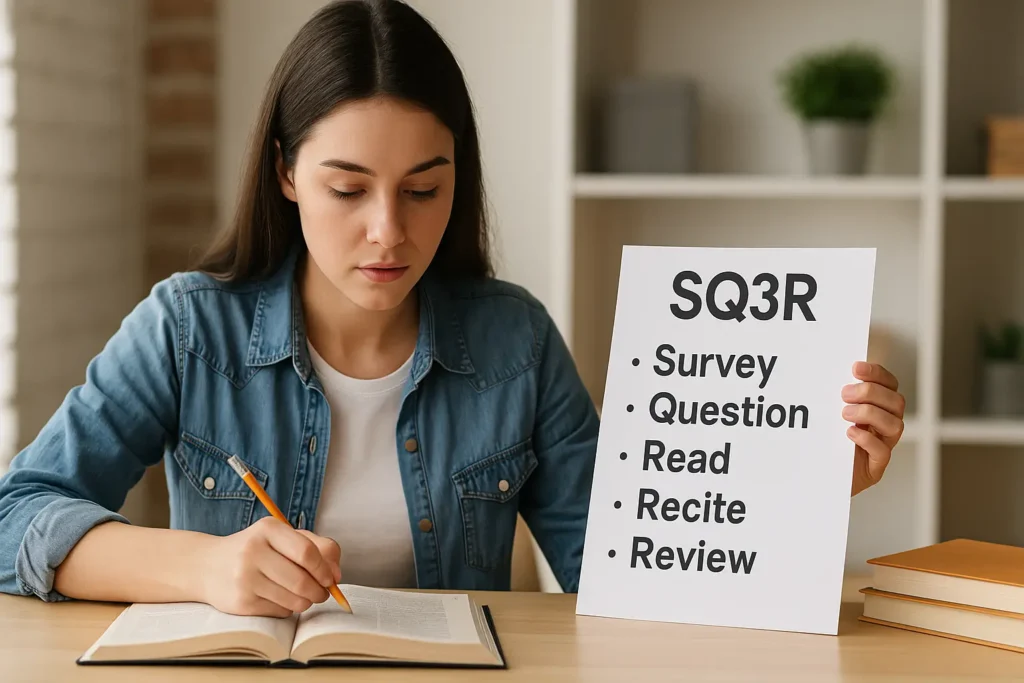
When preparing for public exams or any content-heavy test, one of the greatest challenges is facing dense and complex material. Legal texts, technical manuals, theoretical concepts — they’re often full of terminology, long sentences, and abstract ideas. Reading passively through this kind of content rarely leads to real understanding, let alone retention.
Passive reading — simply scanning words with your eyes — may make you feel like you’re studying, but it doesn’t engage your brain enough to process or retain what you’re reading. That’s why, when you go back to review later, it feels like the material is completely new. This leads to wasted time, frustration, and slower progress.
That’s where active reading techniques come in. By turning reading into a dynamic process — one that involves questioning, summarizing, and interacting with the text — you can extract more value from every study session. In this article, you’ll learn powerful active reading methods that will help you tackle even the most difficult material with focus and efficiency.
Understand the Difference Between Passive and Active Reading
Passive reading is what we often do when reading novels, articles, or casual content. We follow the words without much effort, expecting the meaning to “sink in” naturally. This method doesn’t require attention to structure, logic, or detail — and for light reading, that’s fine. But dense academic content requires more.
Active reading, by contrast, is deliberate and strategic. You’re not just reading to finish a page — you’re reading to understand, connect ideas, and remember what you’ve learned. It involves asking questions, making notes, highlighting key points, and testing your comprehension along the way.
The moment you shift from being a passive reader to an active learner, you begin to notice patterns, arguments, definitions, and exceptions. This awareness increases both retention and understanding, and allows you to use what you’ve read more effectively in essays, exams, and problem-solving.
Start With Pre-Reading Strategies to Activate Your Brain
Before you even begin reading dense content, take a few minutes to preview the material. Skim through headings, subheadings, diagrams, and key terms. This gives your brain a mental map of what to expect and sets a purpose for the reading session.
You can also ask yourself: What do I already know about this topic? and What do I want to learn from this reading? Activating prior knowledge helps your brain connect new information to what you already understand, making the content easier to absorb.
Set a clear goal for each session — for example, “I will understand how administrative law defines public agents.” With a goal in mind, you become more focused and motivated. Pre-reading may seem like a waste of time, but in reality, it prepares your brain to work smarter, not harder.
Use the SQ3R Method: A Proven Framework for Active Reading

One of the most effective active reading strategies is the SQ3R method, which stands for: Survey, Question, Read, Recite, Review. This technique helps you engage with the text from different angles and ensures that you don’t just read — you understand and remember.
- Survey: Quickly scan the section to get a general idea of what it covers. Look at titles, subtitles, highlighted words, and summaries.
- Question: Turn headings into questions. For example, if the heading is “Principles of Civil Law,” ask: What are the main principles? Why do they matter?
- Read: Now read the content with the intention of answering your questions. Focus only on one small section at a time to avoid overload.
After reading, Recite what you’ve just learned in your own words — either by speaking out loud or writing a short summary. Then, Review by going back to your notes, checking what you’ve understood, and reinforcing the key concepts. This method makes even the driest material more engaging and memorable.
Annotate the Text as You Go
Don’t just highlight. Write in the margins. Underline phrases that stand out. Put question marks where things don’t make sense. Draw arrows connecting ideas. This kind of annotation helps your brain stay actively involved and encourages deeper processing of the material.
Try to write brief notes in your own words, rather than copying exact phrases. The act of translating complex sentences into simpler language forces you to truly understand what you’re reading. This also creates personalized study material you can revisit later for quicker reviews.
Be careful not to over-highlight. Many students fall into the trap of coloring entire pages, thinking it helps. In reality, too much highlighting can make the text harder to review later. Focus only on keywords, definitions, and logical connections — not every sentence.
Break the Content Into Manageable Chunks
Dense material is mentally exhausting if you try to tackle too much at once. Divide the reading into small, digestible sections. After each section, pause and summarize it, either mentally or in writing. This approach helps avoid information overload and makes the process feel more achievable.
For example, if you’re reading a legal code with 50 articles, don’t read it all in one go. Start with just five articles, summarize each one, and test yourself on the main ideas. This may seem slower at first, but it leads to stronger long-term retention.
Also, set short time goals, like reading for 25 minutes followed by a 5-minute break (Pomodoro Technique). These focused sessions boost concentration and prevent mental fatigue, especially when reading heavy or technical material.
Teach What You Read — Even If It’s to Yourself
One of the best ways to make sure you’ve understood something is to teach it. After finishing a difficult section, try explaining it out loud as if you were teaching a friend or a class. This technique forces you to organize the information logically and identify any weak points in your understanding.
You don’t need an actual audience. You can teach to yourself in front of a mirror, or record your explanation using your phone. This approach boosts verbal memory, strengthens neural connections, and gives you a powerful review tool you can replay later.
This method, known as the Feynman Technique, is especially effective for abstract or theoretical subjects. If you can explain a complex idea in simple terms, you’ve truly mastered it. If you can’t, that’s a sign you need to revisit that section with more focus.
Review and Reinforce With Purpose
Reading actively is only part of the equation. To truly retain what you’ve learned, you need a review system. Don’t wait for weeks to revisit the material. Use spaced repetition to review key concepts within 24 hours, then again after a few days, and again after a week.
Your reviews don’t have to be long — just skim your notes, test yourself briefly, and revisit the most challenging concepts. Use flashcards, summary sheets, or mind maps to reinforce what you’ve learned in a visual and interactive way.
The key is to review with intention. Don’t just reread — test yourself, recall facts without looking, and write brief summaries. Active reviewing, like active reading, leads to much deeper retention and a greater return on the time you invest.
Final Thoughts: Active Reading Makes Dense Content Possible
Studying dense content doesn’t have to feel like climbing a mountain with no end. With the right strategies, you can turn every reading session into a meaningful and productive experience. Active reading helps you engage deeply, learn faster, and retain information longer.
Rather than dreading complex material, embrace it with confidence. Use tools like the SQ3R method, annotation, self-explanation, and chunking to break the content down and master it step by step. These techniques not only improve your understanding — they also reduce anxiety and boost motivation.
So the next time you face a tough textbook, legal document, or theory-heavy topic, don’t just read — actively study. Make the page come alive by questioning, summarizing, and connecting. Your brain will thank you — and your exam results will show it.